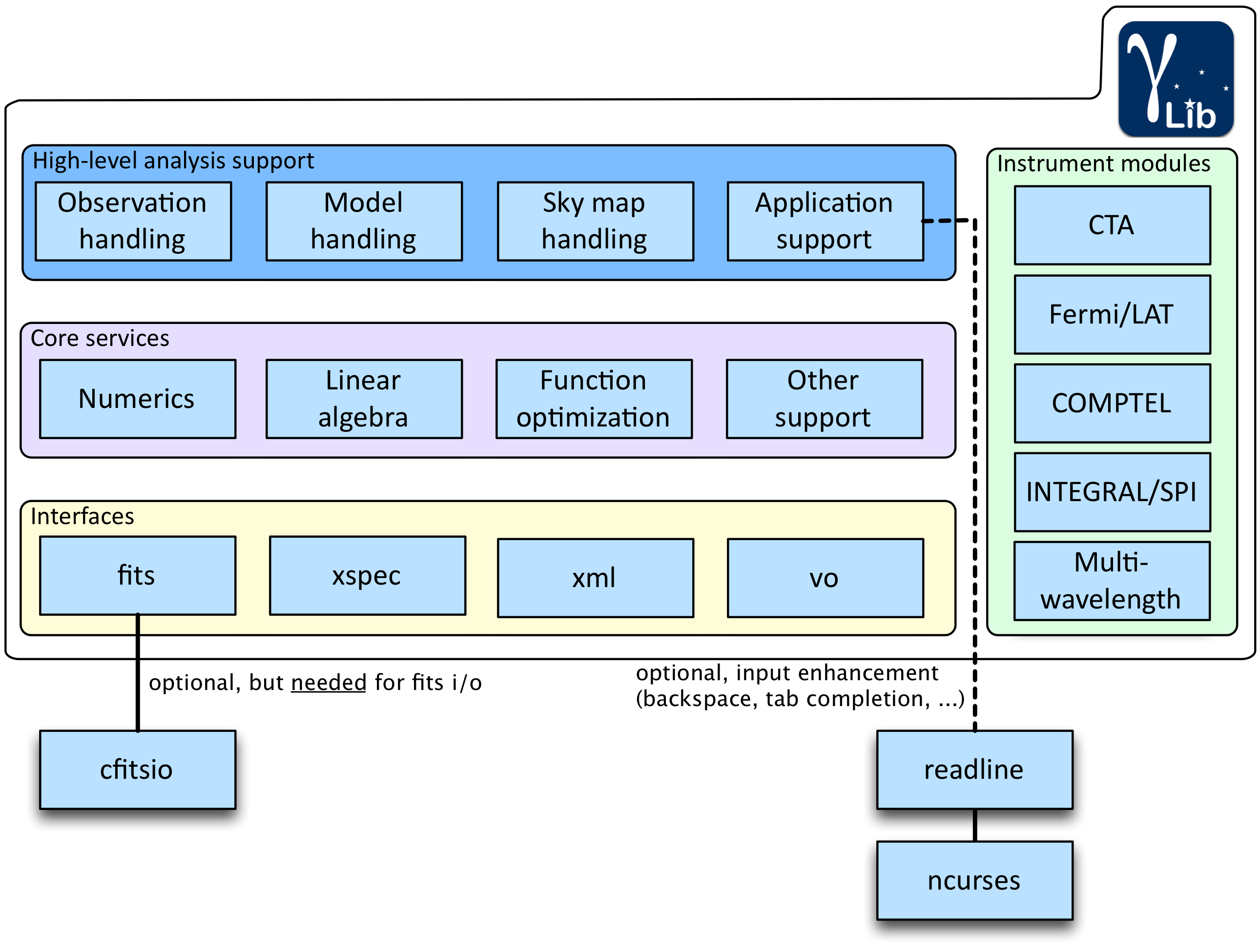Overview¶
GammaLib is a self-contained, instrument independent, open source, multi-platform C++ library and Python module that implements all code required for the scientific analysis of astronomical gamma-ray data. GammaLib works with high-level data, which are data that are already calibrated and that generally come in form of event lists or histograms.
Except for HEASARC’s cfitsio library that is used to implement the FITS interface, GammaLib does not rely on any other third-party software. This makes GammaLib basically independent of any other software package, increasing the maintainability and enhancing the portability of the library.
GammaLib potentially supports any gamma-ray astronomy instrument. Large parts of the code treat gamma-ray observations in an abstract representation, and do neither depend on the characteristics of the employed instrument, nor on the particular formats in which data and instrument response functions are delivered. Instrument specific aspects are implemented as isolated and well defined modules that interact with the rest of the library through a common interface. This philosophy also enables the joint analysis of data from different instruments, providing a framework that allows for consistent broad-band spectral fitting or imaging.
GammaLib source code is freely available under the GNU General Public license version 3. Relevant links for download, issues and documentation are:
Issue tracker: https://cta-redmine.irap.omp.eu/projects/gammalib/issues
Documentation: http://cta.irap.omp.eu/gammalib/
The present document applies to GammaLib version 2.0.
GammaLib is designed to compile on any POSIX compliant platform. So far, GammaLib has been successfully compiled and tested on Mac OS X, OpenBSD, OpenSolaris (using the gcc compiler) and many Linux flavours. Pre-packed binary versions of the code are also available for Mac OS X. For known problems with specific platforms, please refer to the Known issues section.
GammaLib makes heavily use of C++ classes. Instrument independency is achieved by using abstract virtual base classes, which are implemented as derived classes in the instrument specific modules.
GammaLib is organized into four software layers, each of which comprises a number of modules (see GammaLib structure; the quoted module names correspond to the folders in the source code distribution):
High-level analysis support
GammaLib implements classes needed for the instrument independent high-level analysis of gamma-ray data, enabling the joint multi-instrument spectral and spatial fitting by forwards folding of parametric source and background models. This layer comprises modules for instrument independent handling of observations (obs), sky and background models (model), sky maps and sky coordinates (sky), and for the generation of analysis executables in form of ftools (app).
Core services
GammaLib comprise modules for numerical computations (numerics), linear algebra (linalg), parameter optimization (opt), and support functions and classes (support).
Interfaces
are implemented for reading and writing of FITS files (fits), XML files (xml), and Virtual Observatory interoperability (vo).
Instrument specific modules
GammaLib support the analysis of data from the Cherenkov Telescope Array (cta), the Fermi/LAT telescope (lat), the COMPTEL telescope (com), the INTEGRAL/SPI telescope (spi), and any multi-wavelength information in form of spectral data points (mwl).

GammaLib structure¶
GammaLib is developed by a team of enthousiastic gamma-ray astronomers with support from engineers. The development of GammaLib has been initiated by scientists from IRAP (Institut de Recherche en Astrophysique et Planetologie), an astrophysics laboratory of CNRS and of the University Paul Sabatier situated in Toulouse, France. GammaLib is based on past experience gained in developing software for gamma-ray space missions, such as the COMPTEL telescope aboard CGRO, the SPI telescope aboard INTEGRAL, and the LAT telescope aboard Fermi.
